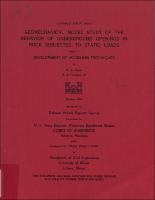Please use this identifier to cite or link to this item:
https://hdl.handle.net/11681/6804Full metadata record
| DC Field | Value | Language |
|---|---|---|
| dc.contributor | University of Illinois at Urbana-Champaign. Department of Civil and Environmental Engineering | - |
| dc.contributor | United States. Defense Atomic Support Agency | - |
| dc.contributor.author | Heuer, R. E. | - |
| dc.contributor.author | Hendron, Alfred Joseph | - |
| dc.date.accessioned | 2016-03-23T20:32:11Z | - |
| dc.date.available | 2016-03-23T20:32:11Z | - |
| dc.date.issued | 1969-10 | - |
| dc.identifier.uri | http://hdl.handle.net/11681/6804 | - |
| dc.description | Contract report | - |
| dc.description | Abstract: Model laws governing the design of geomechanlcal model studies of underground openings in rock subjected to static loads are developed using dimensional analysis and the theory of models. The significant variables influencing the prototype which are considered in this study are free-field stresses, intact rock properties, rock mass discontinuity properties, and the opening geometry. Body forces are considered insignificant as a first approximation. The prototype chosen for study is a short section of a long circular tunnel which is underground at a depth of more than 4 tunnel diameters. The development of a modeling material which successfully models the intact properties of rock is described. It was found that modeling materials described in the literature by previous investigators were not satisfactory because they lacked a sufficiently high angle of internal friction. Satisfactory frictional strength in the materials was achieved by developing mixtures of sand and plaster of Paris with a dense packing of sand grains. The size of the model tested is 24" x 24” x 8”. The design and development of a loading apparatus which allows independent control of the 3 principal stresses on the block is described. Uniformly distributed loads of 96 tons are applied to the 2411 x 811 faces of the model. To maintain a plane strain condition in the model, loads of up to 144 tons are applied to the 2411 x 2411 faces to null strains parallel to the 811 dimension. Friction along the loading faces is controlled with sheets of teflon. Friction losses are reduced to the order of 10% or less of the applied loads. The development of an instrumentation system for the model is described. Of particular interest is the development of techniques for imbedding electrical resistance strain gages within the model material to measure radial and circumferential strains at points within the model around the tunnel. Some tentative observations are made concerning the feasibility of utilizing relatively large scale models to study the behavior of underground openings. | - |
| dc.publisher | Weapons Effects Laboratory (U.S.) | - |
| dc.publisher | Engineer Research and Development Center (U.S.) | - |
| dc.relation | http://acwc.sdp.sirsi.net/client/en_US/search/asset/1048652 | - |
| dc.relation.ispartofseries | Contract report (U.S. Army Engineer Waterways Experiment Station) ; N-69-1 rept.1. | - |
| dc.rights | Approved for public release; distribution is unlimited. | - |
| dc.source | This Digital Resource was created from scans of the Print Resource. | - |
| dc.subject | Dimensional analysis | - |
| dc.subject | Geomechanical models | - |
| dc.subject | Models | - |
| dc.subject | Rock mechanics | - |
| dc.subject | Rock properties | - |
| dc.subject | Static loads | - |
| dc.subject | Tunnels | - |
| dc.subject | Underground openings | - |
| dc.title | Geomechanical model study of the behavior of underground openings in rock subjected to static loads. Report 1, Development of modeling techniques | - |
| dc.type | Report | en_US |
| Appears in Collections: | Contract Report | |
Files in This Item:
| File | Description | Size | Format | |
|---|---|---|---|---|
| CR-N-69-1-Report-1.pdf | 6.23 MB | Adobe PDF |  View/Open |